Yet beneath this technological revolution lies a troubling paradox: as AI's influence expands, advertisers' genuine understanding and control appears to be shrinking. While we celebrate the capabilities these systems deliver, we rarely question what we might be surrendering in the process.
In this article, we’ll break down the biggest blind spots in our industry's AI adoption, highlighting the risks that come with blindly trusting black-box algorithms. More importantly, we’ll explore how advertisers can regain control, by challenging AI’s outputs, demanding transparency, and ensuring that automation works for them, not the other way around.
Blind spot 1: AI is everywhere, but transparency is nowhere
What began as simple automation has evolved into sophisticated systems that make countless decisions about when, where, and how ads appear, often with minimal human oversight. Yet as AI's influence grows, advertisers face a troubling paradox: the very systems they depend on remain largely impenetrable.
Every major platform is now an AI-first ad ecosystem
Google, Meta, Amazon, and TikTok - the platforms that collectively command the majority of digital ad spend - have all transformed into AI-first advertising ecosystems:
- Google's Performance Max campaigns automatically distribute budget across Search, Display, YouTube, and Shopping networks.
- Meta's Advantage+ offerings promise to find the best audience without advertisers specifying targeting parameters.
- Amazon's advertising console increasingly pushes auto-targeting options, while TikTok's algorithm determines content distribution through opaque ranking signals.
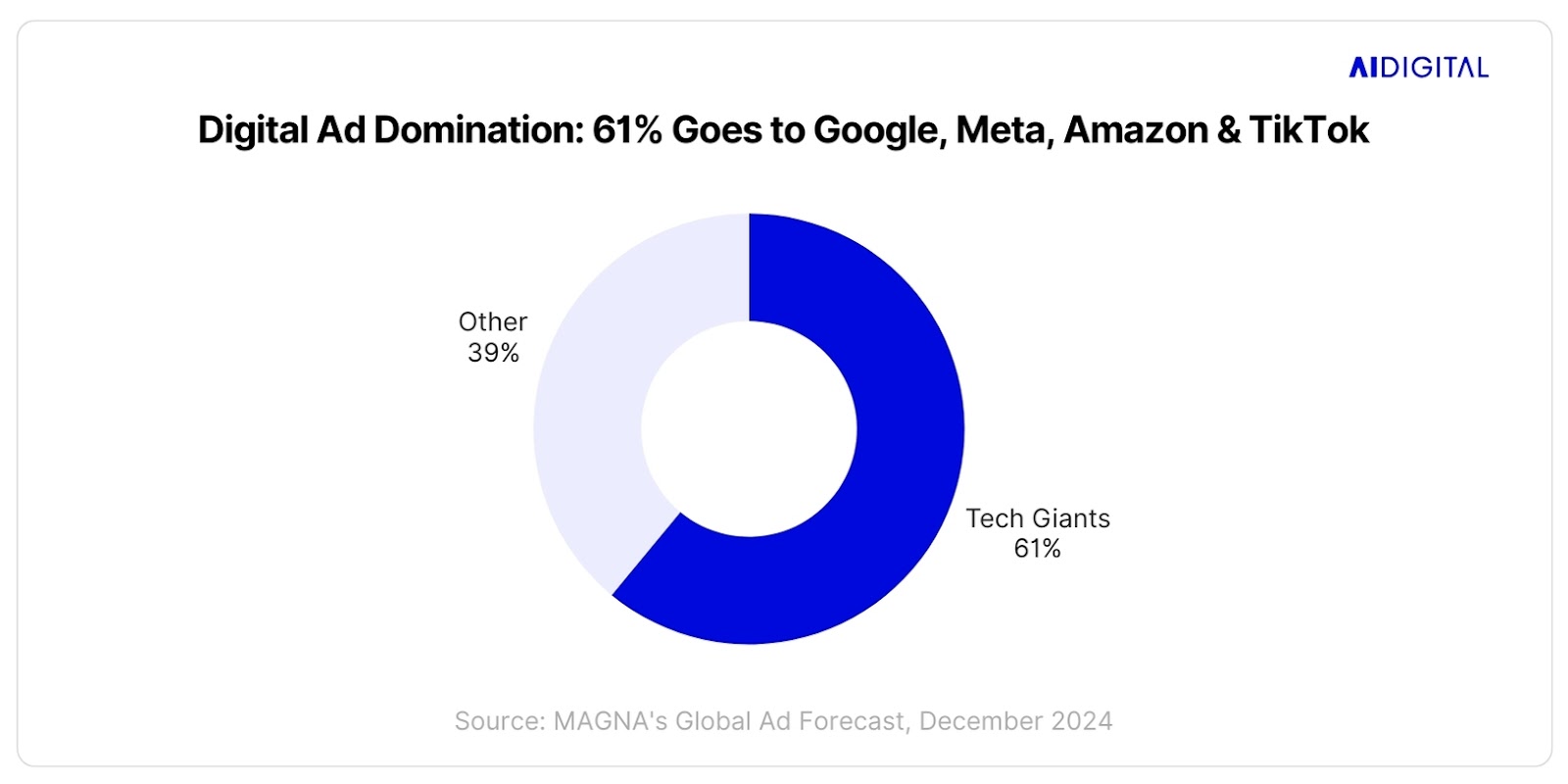
This shift hasn't been gradual, it's been a wholesale transformation. Platforms that once provided granular controls have steadily replaced them with "smart" solutions that promise better performance through algorithmic optimization. The message is clear: trust the AI to deliver results.
"Google Ads sales reps are increasingly contacting agencies' clients with advice that at times contradicts agency strategies–-and in some cases mismanages campaigns," reports Digiday in March 2025. As one agency executive described it, the relationship has become a "prisoner's dilemma"—agencies are turned off by Google’s tactics but too reliant on the platform to walk away. This illustrates how AI automation is fundamentally shifting power to platforms while trapping agencies between efficiency gains and loss of control.
AI is optimizing spend, automating creative, and predicting audience behavior
Behind the scenes, these AI systems are making critical decisions that directly impact advertising effectiveness. They determine bid amounts in real-time auctions, predict which creative variations will perform best, and identify audience segments most likely to convert—all at a scale and speed impossible for human marketers.
Research from the Marketing AI Institute highlights how these systems automatically manage ad performance and spend optimization, often making decisions entirely independently. The promise is compelling: superhuman efficiency and effectiveness through data-driven decision making. Yet, this efficiency comes with a significant cost.
But how much do advertisers truly control?
The uncomfortable reality is that advertisers have progressively surrendered control to these AI systems. Campaign managers who once adjusted bids by keyword now set overall budgets and objectives, with platforms determining how to distribute spend. Creative teams that crafted specific messages for defined audiences now upload multiple assets and let algorithms mix and match them for unknown segments.
Perhaps most concerning is the research showing a stark disparity in perception: while 77% of advertisers view AI positively, only 38% of consumers share this sentiment, according to data from Advanced Television. This gap suggests that the industry's enthusiasm for AI may be outpacing its ability to ensure these tools serve both brand and consumer interests effectively.
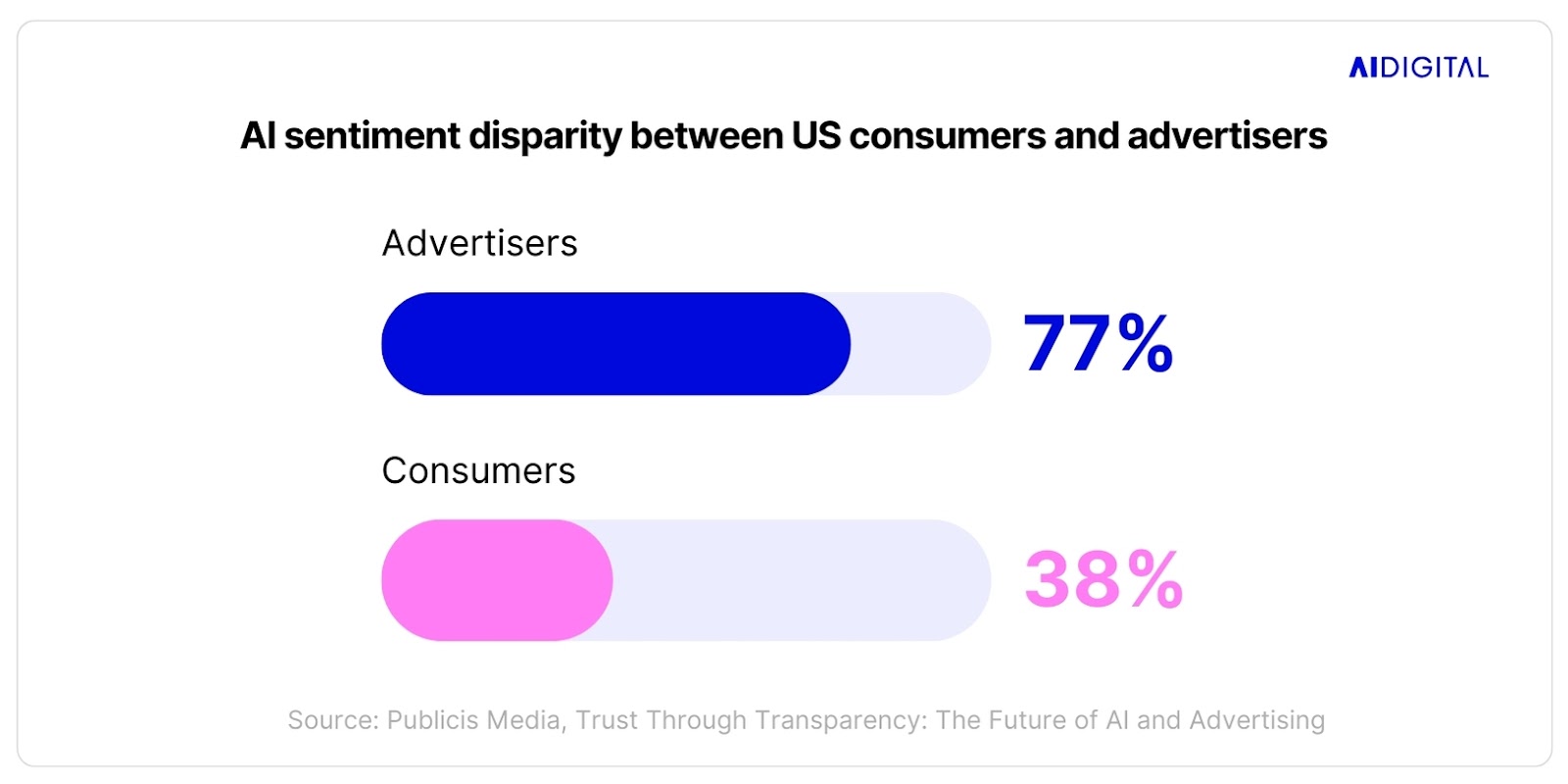
Walled gardens own the AI models, train them on their own data, and set the rules
The fundamental challenge is that platforms maintain complete ownership of their AI systems. These "walled gardens" develop proprietary algorithms trained on their own vast datasets, with methodologies protected as competitive advantages. They establish the operating parameters, determine what metrics to optimize for, and decide what information to share with advertisers.
This creates an inherent conflict of interest. Platforms are incentivized to maximize their revenue, not necessarily advertiser outcomes. Without transparency into how AI systems function, brands cannot verify whether recommendations truly serve their best interests or the platform's bottom line.
When performance declines, advertisers have limited recourse. They can't effectively troubleshoot what went wrong because they can't see the underlying factors influencing AI decisions. Instead, they must either accept the platform's explanation or withdraw their investment—neither of which represents a satisfactory solution for brands investing millions in these channels.
As we continue to surrender strategic control to these opaque systems, we must ask: are we making an informed trade-off between convenience and transparency, or simply accepting a new status quo without fully understanding its implications?
Blind spot 2: We’re optimizing ads, but are we optimizing impact?
The digital advertising industry has embraced AI's ability to optimize campaign performance with remarkable efficiency. Algorithms can instantly analyze thousands of data points to maximize clicks, conversions, and engagement, delivering impressive short-term metrics that satisfy immediate business goals. Yet beneath these surface-level accomplishments lies a deeper question: are we sacrificing meaningful brand impact in the pursuit of algorithmic efficiency?
AI excels at metrics, but can it master brand storytelling?
AI systems excel at optimizing for measurable outcomes (click-through rates, cost-per-acquisition, and conversion metrics) because these data points are quantifiable and occur within compressed timeframes. What's less certain is AI's ability to nurture the elements that build enduring brands: compelling storytelling, emotional resonance, and authentic human connection.
Research supports this concern. According to data from Marketing-Interactive, approximately 50% of consumers can identify AI-generated copy, suggesting that audiences can detect when content lacks authentic human nuance. This perception gap matters because brand trust and loyalty are built on perceived authenticity and emotional connection—qualities that AI-driven content may struggle to replicate convincingly.
While studies from ResearchGate indicate that AI marketing activities can positively impact brand equity in some contexts, such as retail banking, the evidence remains mixed and highly contextual. The research doesn't conclusively demonstrate that AI can match human creativity in building lasting brand narratives that resonate on an emotional level.
AI-generated content is flooding digital spaces
The proliferation of AI-generated content across digital channels has been extraordinary. From automated social media posts to dynamic ad creative that adjusts in real-time, AI is producing marketing materials at unprecedented scale and speed. This efficiency has made it possible for brands to maintain a consistent presence across numerous touchpoints without proportionally increasing their creative resources.
However, this volume-based approach carries significant risks. As noted by Kantar, "Producing a lot more advertising could also mean running the risk of just adding to clutter and not delivering on business objectives." The ability to generate content at scale doesn't necessarily translate to creating content that builds meaningful connections with audiences.
The industry's emphasis on content volume and optimization metrics may be distracting from crucial questions about quality, relevance, and emotional impact. AI can help brands speak more frequently, but not necessarily more meaningfully.
Consumers can spot the difference between human and AI narratives
As mentioned earlier, the 50% detection rate highlighted by Marketing-Interactive suggests that audiences perceive qualitative differences that metrics alone might miss. As consumers become increasingly familiar with AI-generated content, this detection ability may continue to strengthen.
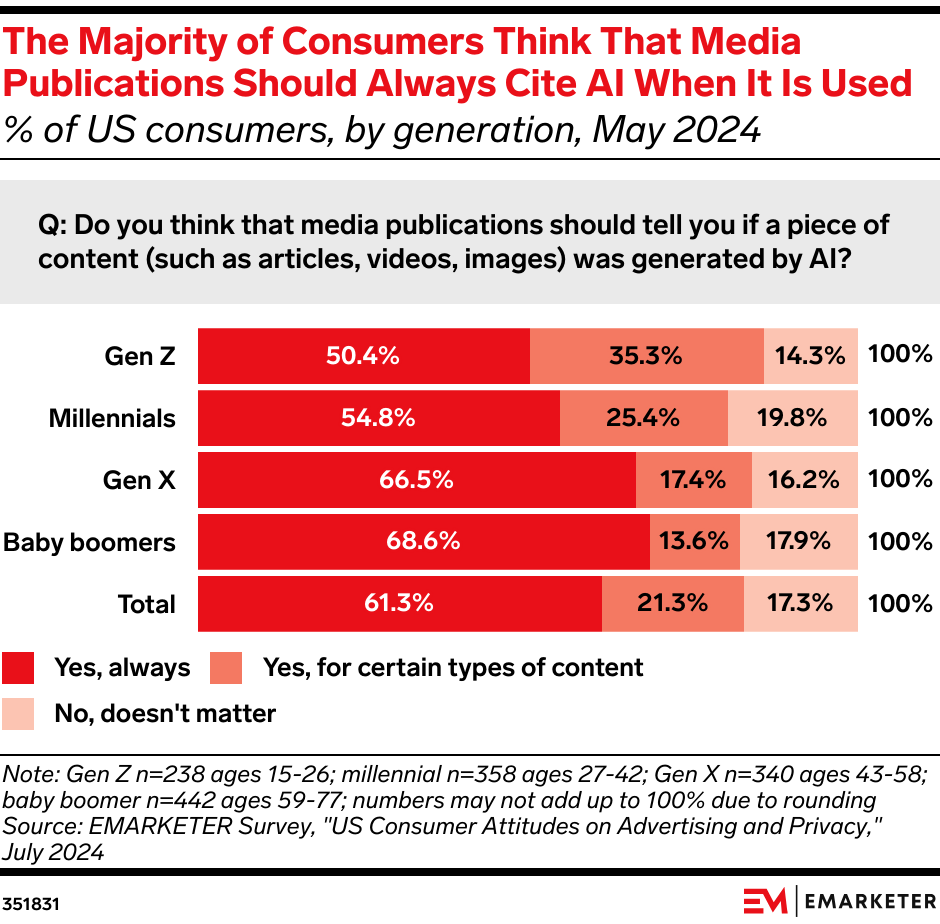
This represents a fundamental challenge for brands. If consumers consistently perceive AI-generated content as less authentic or engaging than human-created alternatives, the efficiency gains of automation could be offset by diminished brand trust and emotional connection. The metrics might improve while the actual brand-consumer relationship deteriorates.
In BuiltIn's critique of AI personalization, they note that "AI knows facts and figures about your customers, but nothing about them as human beings. AI-generated content can feel inauthentic." This observation highlights the essential tension between algorithmic optimization and human connection.
Should we let AI lead creative strategy?
The fundamental question facing advertisers is no longer whether AI can generate marketing content (clearly it can) but whether it should drive creative strategy. As we delegate more decision-making to algorithms optimizing for quantifiable metrics, we risk overlooking the qualitative elements that build enduring brands.
The Harvard Business Review emphasizes that "AI isn't ready to assume human qualities that emphasize empathy, ethics, and morality," suggesting that creative leadership still requires human judgment, particularly for emotional and value-based messaging. While AI can be an invaluable tool for optimization and efficiency, it may not yet be equipped to make the strategic creative decisions that define a brand's voice and relationship with its audience.
This presents advertisers with a critical challenge: how to leverage AI's extraordinary capabilities for optimization while ensuring that human creativity, empathy, and strategic thinking continue to guide brand storytelling. Finding this balance may be the key to avoiding the blind spot of mistaking algorithmic efficiency for meaningful brand impact.
Blind spot 3: The illusion of personalization
The marketing industry has embraced personalization as the holy grail of consumer engagement. AI-powered tools promise to deliver individualized experiences that speak directly to each consumer's unique preferences and needs. Yet beneath this appealing narrative lies a more complex reality: much of what passes for "personalization" may actually be an accelerated form of the same segmentation marketers have practiced for decades, now dressed in AI's clothing.
AI promises personalization at scale, but reality falls short
The promise of AI-driven personalization is compelling: algorithms that analyze vast datasets to create truly individualized experiences for millions of consumers simultaneously. This vision suggests marketing that adapts in real-time to each person's unique context, preferences, and behaviors, moving beyond broad demographic categories to genuine one-to-one communication. And while AI can process enormous amounts of data about consumer behavior, it may struggle to translate this into authentic human connection.
What many brands describe as "personalization" often amounts to faster, more granular segmentation—dividing audiences into increasingly narrow buckets rather than truly personalizing at the individual level. The algorithms identify patterns and group similar users together, but rarely treat each consumer as genuinely unique. This approach represents an evolution of traditional marketing methods rather than the revolution often portrayed in marketing literature.
First-party data is the new gold standard, but infrastructure lags
As third-party cookies and other tracking mechanisms face regulatory and technical restrictions, first-party data—information collected directly from consumer interactions with a brand—has become increasingly valuable. This shift has been widely acknowledged as essential for effective personalization in the evolving digital landscape.
However, the industry faces a significant challenge: while 95% of marketers find AI effective for certain types of personalization according to eWeek data, many organizations lack the infrastructure to fully leverage first-party data. The research from Bloomreach notes that smaller businesses in particular face cost barriers to implementing sophisticated AI personalization systems.
This creates a widening gap between large enterprises with robust data infrastructure and smaller organizations that struggle to collect, integrate, and activate first-party data effectively. The technical requirements—data lakes, integration frameworks, machine learning capabilities, and skilled personnel—represent substantial investments that many brands haven't yet made or cannot afford.
The result is a bifurcated market where a small number of data-rich companies can approach true personalization while most brands rely on more limited approximations. This disparity rarely features in marketing discussions about AI's capabilities, creating unrealistic expectations about what most organizations can realistically achieve.
When personalization becomes surveillance: Drawing the line
Perhaps the most profound concern with AI-driven personalization is the increasingly blurry boundary between helpful customization and invasive surveillance. As algorithms track and analyze more aspects of consumer behavior, personalization efforts can cross from welcome relevance into uncomfortable intrusion.
AdExchanger highlights this risk, noting that personalization can actively alienate customers if it feels too accurate or reveals too much knowledge about their personal lives. The uncanny valley of personalization, where marketing becomes so targeted that it provokes discomfort rather than connection, represents a significant ethical and strategic challenge.
This challenge is particularly acute because consumer attitudes about data collection and personalization vary widely. With 53% of consumers unfamiliar with companies' use of AI in advertising, many may be unaware of how their data is being used to shape their experiences.
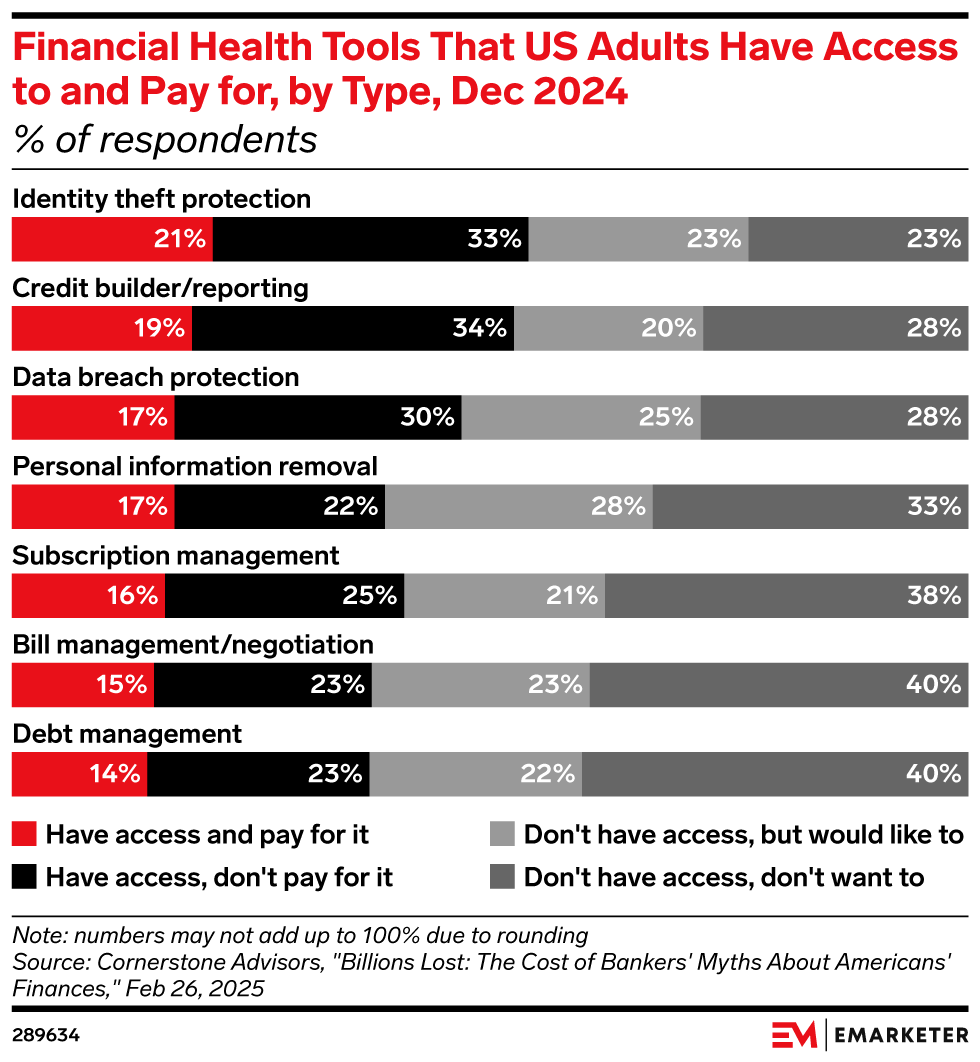
As brands pursue increasingly sophisticated personalization, they must navigate complex questions about transparency, consent, and consumer comfort. At what point does personalization cross the line from helpful to creepy? How explicitly should brands disclose their use of AI and personal data? These questions have no simple answers, yet addressing them thoughtfully is essential for maintaining consumer trust.
The personalization paradox—that consumers want relevant experiences but are uncomfortable with the data collection required to create them—represents a fundamental tension that marketers must acknowledge rather than ignore. Finding the balance between effectiveness and ethics will likely define the future of AI-driven personalization in advertising.
Blind spot 4: AI-driven efficiency vs. AI-driven decision-making
While AI's ability to process data and optimize campaigns at scale offers unprecedented efficiency, it also fundamentally shifts the relationship between human strategists and the technology they employ. This transition raises profound questions about who (or what) controls the strategic direction of advertising efforts and whether efficiency gains might come at the cost of strategic oversight.
AI should be a tool that augments strategy, not the strategist itself
The ideal relationship between AI and marketing professionals is complementary: algorithms handle data-intensive, repetitive tasks while humans provide strategic direction, creative vision, and ethical oversight. This partnership allows each to focus on their respective strengths: AI on processing vast datasets and identifying patterns, humans on understanding context, building narratives, and making value judgments.
However, as AI systems become more sophisticated, the boundary between tool and strategist is blurring. Research from the Marketing AI Institute documents how advanced AI can "automatically manage ad performance and spend optimization, making decisions entirely on its own." This autonomous decision-making represents a significant shift from earlier systems that merely executed human-directed commands. But despite these advances, AI systems still cannot fully grasp empathy, ethics, and morality. These limitations are particularly relevant in advertising, where effective communication requires understanding human emotions, cultural contexts, and value systems that current AI technology cannot fully comprehend.
Who owns the decisions? The question of strategic control
As AI's role expands from optimization to decision-making, the question of ownership becomes increasingly urgent. When an AI system recommends campaign adjustments, optimizes creative elements, or redistributes budget across channels, it is making strategic decisions that directly impact brand positioning and business outcomes.
The Willy Wonka experience documented by Digivate illustrates the dangers of surrendering strategic control to AI. In this case, AI-generated promotional materials created unrealistic expectations for an event, damaging the brand's reputation and consumer trust. This cautionary example demonstrates how unchecked AI decisions can conflict with broader brand objectives when the technology operates without sufficient human oversight.
A study from AAAI on Meta's ad controls found that AI-mediated targeting can reduce effectiveness without human intervention, suggesting that algorithmic decisions don't always align with marketing goals. This misalignment occurs because AI systems optimize for the metrics they can measure—clicks, conversions, engagement—which may not fully capture brand health, customer loyalty, or long-term business value.
The progressive automation of campaign management creates a risk that marketers might lose the ability to effectively challenge AI outputs, especially if they don't fully understand how these systems make decisions or what factors influence their recommendations. This knowledge gap can foster an unhealthy dependence on AI systems, with marketers accepting algorithm-driven decisions even when they conflict with strategic objectives or brand values.
Google's Performance Max: The Black box problem
Google's Performance Max exemplifies the challenges of maintaining strategic control in an AI-driven advertising landscape. This campaign type automates creative selection, audience targeting, and budget allocation across Google's entire advertising ecosystem, including Search, Display, YouTube, and Shopping networks.
Advertisers provide the assets and set overall objectives, but Performance Max handles virtually everything else. While this promises efficiency and performance gains, it also creates a significant transparency issue: advertisers cannot see exactly how their budget is being allocated, which targeting parameters are being applied, or what factors are driving performance.
This lack of granular insight makes it difficult for brands to truly measure Performance Max's impact at a detailed level or to determine which elements of a campaign are working well and which need refinement. Marketers accustomed to having visibility into keyword performance, audience behavior, and creative effectiveness must now trust a system that provides only aggregated results without explaining its methodology.
The opacity of Performance Max represents a broader industry trend toward "black box" advertising solutions that prioritize convenience and automation over transparency and control. While these tools may deliver short-term performance gains, they potentially undermine marketers' ability to develop strategic insights, build institutional knowledge, and maintain decision-making authority over their advertising efforts.
As these AI-driven systems proliferate, marketers face a fundamental question: are we leading AI, or is AI leading us? The answer will determine whether artificial intelligence serves as a powerful tool that enhances human creativity and strategic thinking or gradually displaces the human judgment that has traditionally guided advertising strategy.
{{blind-spot-table}}
What happens when AI disrupts media economics?
As we’ve discussed, the advertising industry is experiencing a profound economic transformation as artificial intelligence reshapes not just how ads are created and targeted, but also how media is bought, sold, and valued. This shift extends beyond operational efficiency to fundamentally alter the competitive landscape, redistribute advertising dollars, and redefine what constitutes "premium" inventory. As AI increasingly determines where advertising budgets flow, we must examine the economic consequences of allowing algorithms to drive media investment decisions.
AI is making programmatic more efficient but also more concentrated
The programmatic advertising ecosystem, once celebrated for democratizing access to digital advertising, is experiencing a paradoxical evolution under AI's influence. While AI has undoubtedly made programmatic buying more efficient by reducing waste and improving targeting precision, it has simultaneously accelerated market concentration among the largest players.
This consolidation occurs because effective AI requires enormous datasets to deliver optimal performance. Platforms with the most users and deepest data reserves—Google, Meta, Amazon—can develop more sophisticated AI models, which in turn deliver better performance, attracting more advertisers and further concentrating market power. This creates a self-reinforcing cycle where data advantages translate into market dominance.
The result is an increasingly concentrated programmatic landscape dominated by a handful of tech giants. While smaller publishers and independent ad tech companies continue to operate, they face growing disadvantages as they lack the data scale necessary to compete with AI-powered giants. This concentration raises concerns about reduced competition, potential price increases, and diminished innovation across the advertising ecosystem.
Retail media, CTV, and search are shifting ad dollars away from traditional players
The rise of AI-driven advertising coincides with significant shifts in where advertising dollars flow. Retail media networks—advertising platforms operated by retailers like Amazon, Walmart, and Target—have experienced explosive growth as AI enables them to leverage their first-party purchase data for highly effective targeting. Connected TV (CTV) platforms with robust user data are similarly attracting increased investment as AI helps advertisers reach specific audiences in the increasingly fragmented streaming landscape.
This redistribution of advertising budgets has significant economic implications for traditional media players. Legacy publishers, broadcast networks, and other traditional advertising channels are losing market share to data-rich digital platforms that can offer more precise audience targeting through AI systems.
The ScienceDirect study on AI technology transparency, while focused on consumer perceptions, indicates a broader trend: platforms that can demonstrate AI-driven performance advantages are capturing a disproportionate share of advertising budgets. This shift is not merely a change in tactical media allocation but represents a structural transformation of the advertising economy that threatens the survival of media outlets unable to compete in AI-driven targeting capabilities.
The cost of AI-driven media is rising without clear value justification
As advertising platforms integrate more sophisticated AI capabilities, they increasingly position their inventory as premium offerings that command higher prices due to enhanced targeting and optimization capabilities.
This pricing power stems partly from the opacity of AI systems discussed in blind spot one—advertisers cannot fully evaluate whether AI-driven targeting justifies premium prices when they cannot see how these systems operate. The black-box nature of platforms like Google's Performance Max makes it nearly impossible to determine if higher costs truly deliver proportional value.
While specific pricing data remains limited, the industry dynamics suggest a troubling pattern: as AI becomes more embedded in advertising platforms, the price of reaching audiences through these channels continues to rise without corresponding improvements in transparency or performance measurement. Advertisers find themselves paying a premium for AI-optimized inventory without the ability to independently verify its value.
This situation creates an information asymmetry where platforms claim performance improvements to justify higher prices, but advertisers lack the tools to validate these claims. Without greater transparency into how AI determines media value and allocates spend, marketers risk overpaying for inventory whose primary differentiation is simply being labeled as "AI-optimized."
As advertising budgets increasingly flow through AI-driven systems that favor the largest platforms with the most extensive data assets, the economic structure of the advertising industry continues to transform. This evolution raises critical questions not just about efficiency and performance, but about market concentration, competition, and value—questions that remain largely unaddressed.
Final thought: Are we leading AI, or letting AI lead us?
The proliferation of AI across the advertising ecosystem has created remarkable opportunities for efficiency, personalization, and optimization. Yet as we've explored through these blind spots, a more profound challenge emerges: the question of agency and control in an AI-dominated landscape. The most significant blind spot may not be any single technical limitation or transparency issue, but rather our collective willingness to cede strategic decision-making to systems we don't fully understand or control.
The fundamental blind spot in advertising's AI revolution isn't merely technical—it's philosophical. As AI systems become more sophisticated and ubiquitous, we risk becoming passive recipients of their capabilities rather than active directors of their application. This shift happens gradually, as each incremental surrender of control seems reasonable in isolation but accumulates into a profound transformation of what shapes advertising strategy.
The path forward requires a deliberate shift from passive acceptance to active direction of AI in advertising. This means moving beyond viewing AI as merely a technical solution to campaign optimization and recognizing it as a strategic partner that requires clear guidance, boundaries, and oversight.
We, at AI Digital, emphasize this philosophy with our core principle: "AI-Powered, Human-Driven Advertising." This approach recognizes that AI should augment human intelligence rather than replace it, using technology to enhance our capabilities while preserving human judgment in strategic decision-making.
Moreover, AI Digital's Open Garden framework also offers a compelling alternative to the status quo. Unlike the walled garden approach of major platforms that restrict transparency and control, the Open Garden ensures advertisers maintain visibility and agency throughout the advertising process. This framework directly addresses the primary blind spot identified in our analysis - the lack of transparency in AI models used by platforms like Google, Meta, and Amazon. By providing DSP-agnostic execution across more than 15 demand-side platforms, AI Digital ensures that advertisers can make informed decisions based on performance rather than platform preference.
As part of this commitment, Elevate - AI Digital’s proprietary intelligence engine, gives marketers strategic control over planning, optimization, and measurement. With transparent analytics, customizable KPIs, and human-in-the-loop AI, Elevate helps teams align every campaign decision to what matters most: business outcomes. It’s not just smarter AI, it’s AI that works for you, not instead of you.
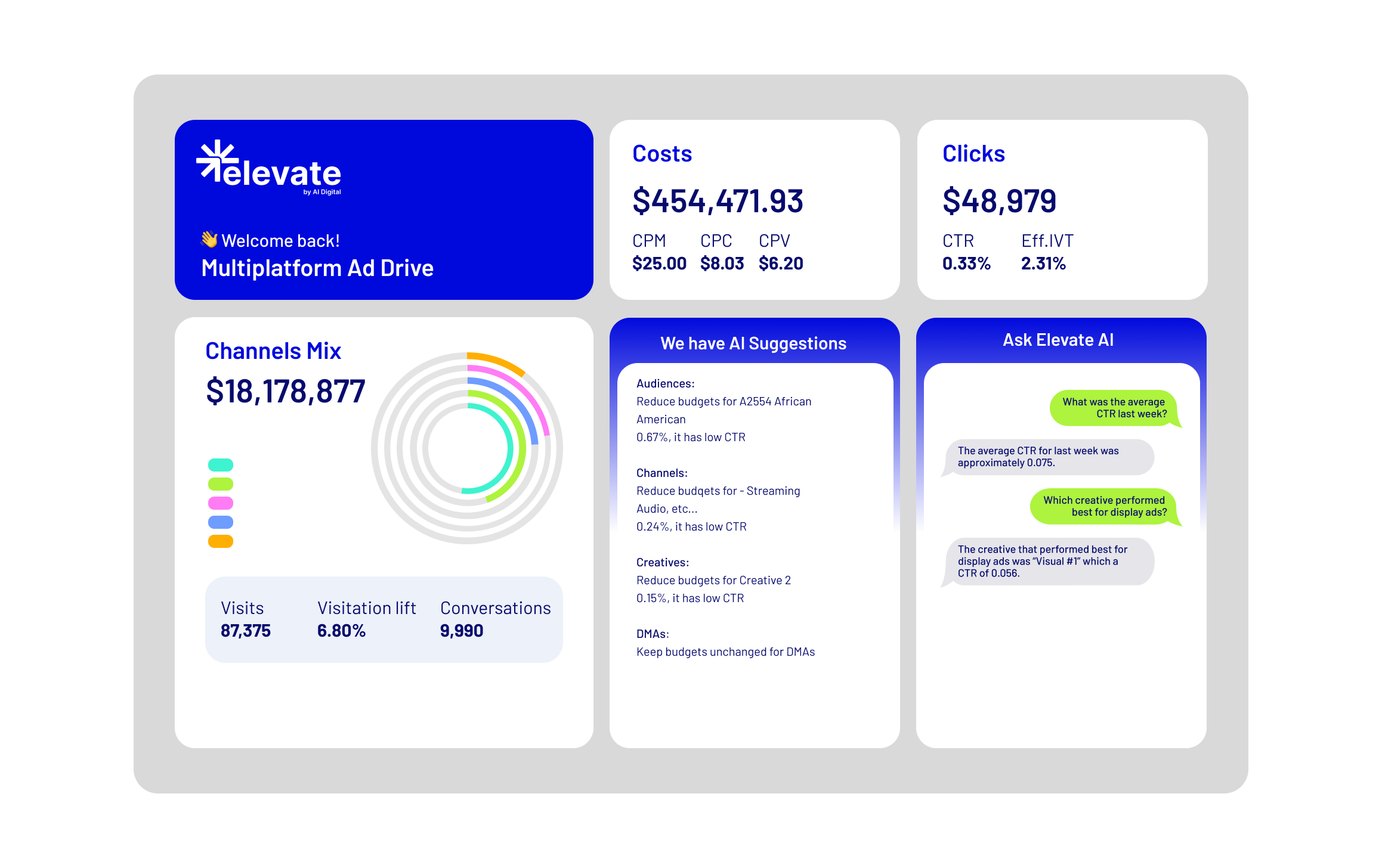
In short, the time has come to move beyond passive acceptance of AI advertising solutions and toward active leadership in how these technologies serve our strategic goals. The question isn't whether AI has a place in advertising—it's whether that place will be determined by technology platforms or by the marketers who understand their brands, audiences, and business objectives best. Whenever you encounter challenges navigating this complex landscape, AI Digital stands ready to help.
Let’s keep the conversation going, feel free to reach out:
📩 Tom Burke
📧 tom.burke@aidigital.com




.jpg)
.jpg)

.jpg)